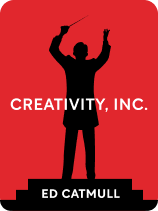

This article is an excerpt from the Shortform book guide to "Creativity, Inc." by Ed Catmull. Shortform has the world's best summaries and analyses of books you should be reading.
Like this article? Sign up for a free trial here .
What are mental models for creative teams? Why do creative teams need these models?
Creative teams can be challenging to manage because creativity isn’t a linear process. Using mental models for your creative teams can help, especially where there is anxiety in the face of uncertainty.
Read more about the mental models for creative teams and how they can help secure results.
Managing Creative Teams
In order to grow as a creative organization, you have to be willing to take risks and dive the unknown. This, however, is easier said than done. Trying to build something out of nothing requires mental fortitude and comfort with uncertainty.
One of the best ways to keep calm in the face of uncertainty is to form a mental model that keeps you focused on your objectives and confident in your decision-making. A mental model is a visualized scenario that represents a process. For example, you may compare your work on a project to climbing a mountain or running a race.
Mental Models for Creative Teams
At the beginning of a project, creative teams don’t know where their project is going to take them. While they may have a plan, the creative process isn’t linear and often veers off in different directions. While the venture into the unknown is necessary, it’s also terrifying.
A natural impulse may be to take control of the situation and try to dictate a specific direction to avoid failing. However, if you begin to overthink every choice that you’re making, you risk stifling the creative process and creating unoriginal work. Instead, you have to become comfortable pushing into the unknown and building a project based upon your discoveries. The more avenues that you explore, the more fleshed out your final project will be.
To help you through your creative project, visualize your process as a journey. As you form your scenario, consider the following factors:
- Know what tools you have at your disposal. You have resources and team members on your side. In your visualization, relate specific tools in your imagined scenario to the resources at your disposal. For example, if you’re visualizing your journey as driving through a long tunnel, you may relate the headlights on your car to your management team because your managers keep you focused on the road ahead.
- Recognize the external factors outside of your control. There will be external things that you will have to navigate as you go through your journey. In your visualization, relate specific factors in your imagined scenario to the uncontrollable obstacles you may encounter in real life. For example, if you’re visualizing your journey as flying a plane, you may relate turbulence to fights between departments.
- Give yourself a goal, even if your final destination isn’t known. Having a goal helps motivate you to continue moving forward. Even if your final destination isn’t definite, you need something to strive for. For example, if you’re visualizing your journey as an archeological dig, you may relate your search for bones or artifacts to finding new ideas and concepts. Even though you don’t necessarily know specifically where to dig, you know that you have to keep on digging.
For example, Pixar director Andrew Stanton believes in the philosophy of “failing fast and failing often.” To him, this means that it’s better to make quick decisions to figure out what works and what doesn’t. To visualize this, he imagines himself captaining a ship on the open sea. He can’t see his final destination, but he knows that he has to keep the ship sailing ahead in hope of finding land. Though he may momentarily navigate his crew in the wrong direction, keeping the ship moving keeps the crew confident that their leader is actively trying to get them to shore. He can’t control the wind or the waves, but he can adjust the course when external factors impact the movement of the ship.
Keep Your Team Creative
Expand your team’s worldview promotes creativity in the workplace and highlight the importance of feedback meetings, research, boundaries, technology, experimentation, attention to detail, postmortems, and learning opportunities
- Frequent feedback meetings are important to stay aware of the goings-on in your workplace. Using Dailies (Pixar’s daily feedback meetings) as a guide, how could you implement regular feedback sessions to keep updated on current projects?
- Research is important to creative work. Think about your current workplace. What resources could you use to promote research in your workplace? This could include trips, online resources, and guest artists.
- Boundaries can help your team discover creative solutions while staying efficient. Think of a project that went overboard with unnecessary details. What boundaries could you have set to help your project stay focused on the important aspects?
- Technology can help artists with their work. Think of a project you’ve worked on that used outdated technology. In what ways could you have used updated technology to make that project more efficient?
- Experimentation leads to innovative and original work. Think of your current workplace. In what ways could you promote experimentation? Think about think-tanks, experimental spaces, and giving employees freedom to solve problems.
- Attention to detail requires that you abandon your preconceived notions. Using Pixar’s drawing class for inspiration, look outside of your window. Find an object and describe what you see. Look for tiny details such as texture and color.
- Postmortems give you the chance to address issues directly following a project. Think about a project you recently completed. Think about three issues you faced during that project and how you plan to address them in future projects.
- Learning opportunities give your employees the opportunity to think out-of-the-box. What opportunities could you offer to your team?

———End of Preview———
Like what you just read? Read the rest of the world's best book summary and analysis of Ed Catmull's "Creativity, Inc." at Shortform .
Here's what you'll find in our full Creativity, Inc. summary :
- How Pixar went from selling computers to successful animation studio
- What it takes to build a creative workplace culture
- Why George Lucas sold Pixar to Steve Jobs






